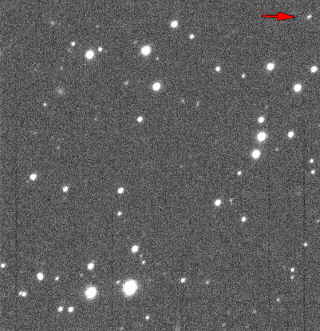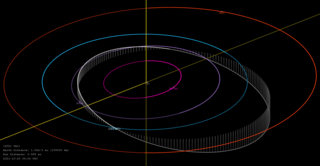Related Research Articles
3551 Verenia, provisional designation 1983 RD, is an Amor asteroid and a Mars crosser discovered on 12 September 1983 by R. Scott Dunbar. Although Verenia passed within 40 Gm of the Earth in the 20th century, it will never do so in the 21st. In 2028 it will come within 0.025 AU of Ceres.
2135 Aristaeus is an Apollo asteroid discovered on April 17, 1977, by E. F. Helin and S. J. Bus at Palomar Observatory. It is named for Aristaeus, the son of Apollo and the nymph Cyrene.

(31669) 1999 JT6 is an Earth-crossing asteroid belonging to the Apollo family of asteroids which also crosses the orbit of Mars. 1999 JT6 is the asteroid's temporary discovery name. It has now been assigned a permanent number from the Minor Planet Center (31669) indicating that its orbit has been confirmed, but has not (at least so far) been assigned a name. Only a small fraction of asteroids have been named.
(5604) 1992 FE is an Aten-type near-Earth minor planet. It was discovered by Robert H. McNaught at the Siding Spring Observatory in Canberra, Australia, on March 26, 1992. The asteroid is 550 meters (1,800 ft) in diameter.
(251732) 1998 HG49, provisional designation 1998 HG49, is a sub-kilometer asteroid and near-Earth object of the Amor group, approximately 200 meters in diameter. It was discovered on 27 April 1998 by astronomers of the Spacewatch program at the Kitt Peak National Observatory near Tucson, Arizona, United States.
(7341) 1991 VK is a near-Earth minor planet in the Apollo group. It was discovered by Eleanor F. Helin and Kenneth J. Lawrence at the Palomar Observatory in California on 1 November 1991. It is listed as a potentially hazardous object. Every 5 years the asteroid makes a close approach to the Earth. The most recent close approach to Earth was on Jan 25, 2017; the next close approach will be on Jan 25, 2022 at a distance of 0.064 AU.

(511002) 2013 MZ5, provisional designation 2013 MZ5, is a sub-kilometer asteroid, classified as a near-Earth object of the Amor group, estimated to measure approximately 300 meters (1,000 feet) in diameter. It was discovered on 18 June 2013, by astronomers with the Pan-STARRS survey at Haleakala Observatory on the island of Maui, Hawaii, in the United States. It was the 10,000th near-Earth object ever discovered.
(523662) 2012 MU2, provisional designation 2012 MU2, is a sub-kilometer asteroid on an eccentric orbit, classified as near-Earth object and potentially hazardous asteroid of the Apollo group. It was discovered on 18 June 2012 by astronomers of the Catalina Sky Survey at an apparent magnitude of 19.9 using a 0.68-meter (27 in) Schmidt–Cassegrain telescope. It has an estimated diameter of 240 meters (790 ft). The asteroid was listed on Sentry Risk Table with a Torino Scale rating of 1 on 23 June 2012.
(89958) 2002 LY45 is an asteroid, classified as near-Earth object of the Apollo group that is also a Mercury-crosser, Venus-crosser, and Mars-crosser. It was discovered by the LINEAR program on 14 June 2002.
2012 FN is an Apollo asteroid and a near-Earth object that has a 1 in 4 billion chance of impacting Earth on 7 March 2113. It is estimated to be 5 meters in diameter, which means that it poses no threat if it impacts Earth. An impact would have the kinetic energy of about 3 kt of TNT, and would probably result in an air burst in the upper atmosphere. It is the least threatening asteroid listed on the Sentry Risk Table. The very short observation arc of only 3 hours results in a very poorly constrained orbit, and it could just as easily be 2 AU from Earth on 7 March 2113.
2011 GA is a small asteroid that is a Near-Earth object and an Apollo asteroid.
(549948) 2011 WL2 is a sub-kilometer asteroid, classified as a near-Earth object and potentially hazardous asteroid of the Apollo group. It was discovered on 16 November 2011, by astronomers with the LINEAR at the Lincoln Laboratory ETS near Socorro, New Mexico, in the United States.

2016 AZ8 is a sub-kilometer asteroid and near-Earth object of the Apollo group, at least 400 meters (1,300 feet) in diameter. It was first observed on 3 January 2016, by the WISE telescope with precovery images found back in 2012.

2019 AS5 is a near-Earth asteroid that passed close by the Earth on 8 January 2019. It passed within 0.04 lunar distances or 15,000 kilometers of the center of the Earth, 8600 km from the surface. It was discovered by the Mt. Lemmon Survey 9 hours after closest approach. It is estimated to be about 1–2 metres (3–7 feet) in diameter.

2002 NY40 is a sub-kilometer near-Earth object and potentially hazardous asteroid of the Apollo group, approximately 800 meters (2,600 feet) in diameter. The contact binary with a bilobated, peanut-like shape was first observed on 14 July 2002 by the LINEAR automated system in New Mexico. On 18 August 2002, it passed Earth at a distance of 540,000 km. It was observed with adaptive optics by the Midcourse Space Experiment.
(458732) 2011 MD5 is an Apollo near-Earth asteroid around 1.2 kilometers (0.75 miles) in diameter. It is the largest asteroid known to have passed closer than the Moon. On 17 September 1918 the asteroid passed 0.00234 AU (350 thousand km; 0.91 LD) from Earth with a peak apparent magnitude of around 8.4. The 1918 close approach distance is known with an accuracy of roughly ±120 km. The asteroid had come to opposition (opposite the Sun in the sky) on 9 August 1918 at magnitude 16.
2020 AP1 is an Apollo near-Earth object roughly 5 meters (20 feet) in diameter. On 2 January 2020 it passed 0.00218 AU (326 thousand km; 0.85 LD) from Earth. With a short 1-day observation arc it was roughly expected to pass about 0.01 AU (1.5 million km; 3.9 LD) from Earth on 7 January 2022, but with an uncertainty of ±8 days for the close approach date it could have passed significantly closer or further.

2021 UA1 is a small (~2 meter) near-Earth object that passed about 3047 km from the surface of Earth while passing over Antarctica on 25 October 2021 around 03:07 UT. Given the small size of the asteroid it only reached the brightness of Pluto at around apparent magnitude 14. Since it approached from the direction of the Sun, it was not discovered until 4 hours after closest approach.

2022 WM7 is a small near-Earth asteroid that passed about 0.2 lunar distances (77,000 km; 48,000 mi) from Earth's center on 28 November 2022 at 02:24 UTC. It was discovered by the Pan-STARRS 1 survey telescope at Haleakalā Observatory, Hawaii on 26 November 2022.

2022 YG is a near-Earth asteroid and a potential quasi-satellite of Earth, discovered by amateur astronomer Gennadiy Borisov at Nauchnyi, Crimea on 15 December 2022. It has an estimated diameter of 16–30 meters, given H of 26.6, and an albedo 4-15%.
References
- ↑ "(3553) Mera = 1985 JA". Minor Planet Center . Retrieved 4 June 2015.
- ↑ "3553 Mera (1985 JA)". JPL Small-Body Database . NASA/Jet Propulsion Laboratory . Retrieved 14 April 2016.
- ↑ Schmadel, Lutz D. (2003). Dictionary of Minor Planet Names. Springer Science & Business Media. pp. 298–299. ISBN 978-3-540-00238-3.